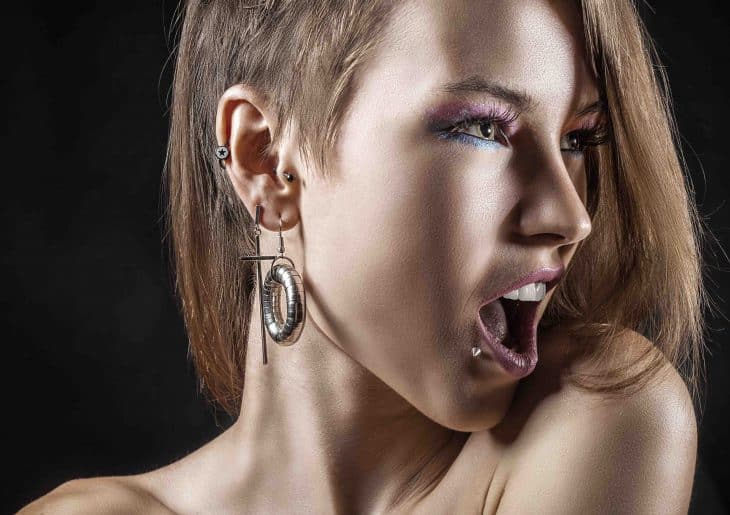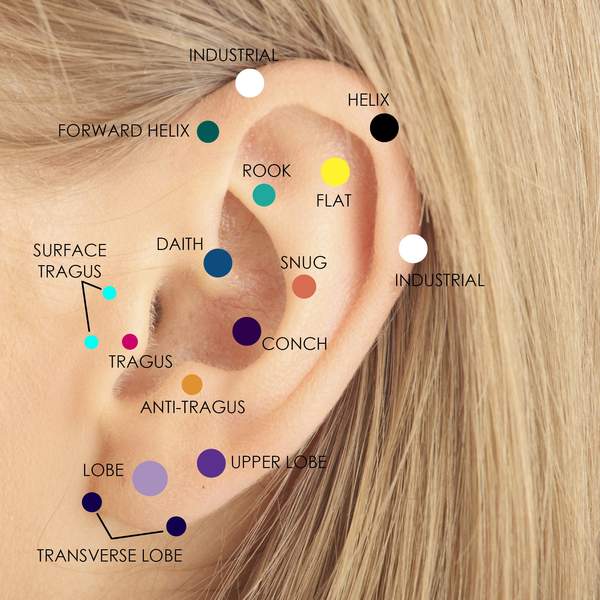
Ear piercings have gained massive popularity over the years, and it isn’t all that surprising. Ear piercings are great fashion accessories that are easy to customize according to the occasion and your own personal style. There are so many types of ear piercings out there. They are so versatile that they can serve as subtle accents in your outfit or as the star of your ensemble. You can mix and match which ones you want to get.
If you’re thinking about which types of ear piercings to get, you might get overwhelmed by the different factors that you need to consider. Sometimes, even just the ear-piercing names can be hard to remember. Worry not because this list got you covered! From the location to the pain scale, this guide on the different types of ear piercings is sure to help ease your decision-making.
Choosing the Types of Ear Piercings You Want
Aside from finding the right piercer (which we will talk about at the end of the article), you will also need to consider factors such as the location, pain scale, and healing time. The ear might seem like a small body part to you at first, but there are actually 13 different types of ear piercings that you can get! Each type varies; thus, its location, pain scale, and healing time will be different.

Lobe Piercings
Lobe piercings are the most common type of ear piercings out there. In fact, most people will probably have lobe piercings as their first ear piercing ever. This is because lobe piercings are the least painful to have. They sit on your earlobe, where it’s all flesh and no bone. While everybody’s sensitivity levels to pain differ, piercers can agree that most lobe piercings won’t exceed a score of 6 out of 10 on the pain scale, with 10 being the most painful. Plus, lobe piercings heal faster and are easier to clean.
1. Standard Lobe Piercing
The standard lobe piercing is a simple piercing through the lobe. Your piercer simply has to prick your lobe with the piercing needle, from the inside and then outside, and then you’re done! This standard lobe piercing usually heals within 1 to 2 months. It can, however, take longer if you get double or even triple lobe piercings.
2. Transverse Lobe Piercing
This type of ear piercing is also on the lobe. However, unlike the standard lobe piercing, the transverse lobe piercing runs horizontally on the earlobe. There are different ways to experiment with a transverse lobe piercing, but your ear shape will limit your choices. If you’re unsure what angle and size are possible for your ear shape, don’t be afraid to ask your piercer.
However, keep in mind that a transverse lobe piercing will heal relatively slower than a standard lobe piercing. Some extreme cases take up to ten months to heal. Everybody’s body works differently, so it’s important to pay close attention to your piercings.
3. Orbital Piercing
The orbital piercing refers to any two piercings connected with a single earring such as a piece of hoop jewelry. Usually, you can find orbital piercings on the earlobe, as it offers a lot of space for side-by-side piercings. However, some also get orbital piercings on their inner ears.
Like the transverse lobe piercing, it heals slower because it requires two perforations, so healing time can range from four months to a year.
Outer Ear Piercings
Outer ear piercings are types of ear piercings that lie on the curve of your outer ear. Thus, piercers classify these as cartilage piercings. These types of ear piercings require your piercers to puncture through cartilage, the hard tissue that provides structure to your external ear. It is a case-to-case basis, but you can expect outer ear piercings to be more painful than lobe piercings. They will also take a relatively long time to heal.
4. Tragus Piercing
This type of ear piercing adorns the tragus. The tragus is the tiny flap that covers your ear canal. It is the type of ear piercing that is closest to the face. You’ll find that most piercers will also warn you about its aftercare, as it will inhibit you from wearing earphones. Wearing earphones with a fresh tragus piercing can put you at risk for an infection. Putting them on and taking them off repeatedly can easily irritate the skin there.
As a cartilage piercing, the tragus piercing is around a 6 out of 10 on the pain threshold, and it will take around two months to heal.
5. Snug Piercing
Also known as the anti-helix piercing, snug piercing is a type of piercing that many consider being the most painful. It sits on your ear’s anti-helix, which is the rim of cartilage inside your ear above the anti-tragus. This type of ear piercing is less common than other ear piercings, so you will definitely get noticed with this one. However, not all ear shapes allow for a snug piercing. A go signal from your piercer will be necessary before you can get one.
Like most cartilage piercings, the snug piercing is around a 7 out of 10 on the pain scale and will take up to four to six months to heal. However, some can last up to a whole year, so you really have to be ready to commit to lengthy aftercare here.
6. Forward Helix Piercing
The forward helix piercing lies on the helix or the curve of your ear. However, unlike a regular helix piercing, it sits a little lower on your ear, closer to where the curve of your ear meets the side of your face. Depending on your ear shape, you can get multiple forward helix piercings, but most of the jewelry used for this type of ear piercing is studs.
The forward helix piercing is around a 5 to 6 out of 10 on the pain scale, and it will take around three to nine months before it fully heals.
7. Industrial Piercing
Industrial piercings are Instagram favorites. Some call the industrial piercing “scaffold,” “bar piercing,” or “construction piercing.” Industrial piercings sit on your upper ear cartilage. And like the transverse lobe piercing, they are a horizontal bar that calls for two holes that span your ear cartilage. This piercing is easily one of the most eye-catching piercings, but it is also one of the most painful to have.
Most piercers claim that industrial piercing is a 7 out of 10 on the pain scale. The healing time can range from four months to a whole year. The aftercare can also be taxing. You are cleaning two different piercings, after all.
If you decide on getting an industrial piercing, you’ll have to be extra mindful when you’re taking off your shirt or combing through your hair. As pretty as this type of ear piercing is, it is much more prone to irritation.
8. Auricle Piercing
Some people prefer having only one ear piercing, but for those who like to curate ear piercings, the auricle piercing is a popular choice to complete the look because of its location. The auricle piercing sits just inside the outer part of the ear, in between the lobe and the helix. The auricle piercing is also easy to decorate. You can choose different types of earrings. Some popular types of earrings for an auricle piercing are captive bead rings, cartilage studs, and hoops.
Most piercers claim that this type of piercing is around a 7 out of 10 on the pain scale. It will take roughly around three to five months of healing time.
Inner Ear Piercings
As the name shows, inner ear piercings are types of piercings that sit on your inner ear. These types of ear piercings will also involve piercing the cartilage of your ear. Like outer ear piercings, inner ear piercings will be more painful than lobe piercings. However, since they aren’t as exposed as outer ear piercings, they can heal faster, given that proper aftercare is done consistently.
9. Anti-Tragus Piercing
You can find an anti-tragus piercing sitting on the piece of cartilage right above your lobe and opposite the tragus. This type of ear piercing is especially popular among individuals who are interested in constellation piercings. However, not all ear shapes can accommodate an anti-tragus piercing. This is especially true if your ears are already adorned with several lobe piercings.
Piercers believe that this type of ear piercing can be painful even after the session, with a pain threshold of 6 to 7 out of 10. As always, healing time will vary, but it usually takes around three to nine months.
10. Helix Piercing
One of the most popular types of ear piercings is helix piercing. A helix piercing is a cartilage piercing that sits on the upper part of the ear. Because of the ample space on the upper part of the ear, plenty of individuals will opt for a double or triple helix. Helix piercings are especially versatile, so you can choose from different types of earrings once it fully heals.
This helix piercing is low on the pain threshold at a 4 out of 10, although some will rate it up to a 7 out of 10. It is around the average healing time of three to six months.
11. Rook Piercing
In the inner ridge of the ear cartilage is where you can find a rook piercing. The shell of your ear nestles protectively around this type of piercing, so it is less likely for a rook piercing to catch onto clothing. Popular earring choices for this type of ear piercing are hoops and barbells.
Like most types of ear piercings, the rook piercing is around a 6 out of 10 on the pain scale and can take around six months to a year to heal, depending on how committed you are to its aftercare.
12. Daith Piercing
Despite being a little more hidden than the other ear piercings, the daith piercing easily stands out as a popular favorite. You can find a daith piercing at the innermost part of your ear cartilage, near the tragus. Some people believe daith piercings can help ease migraines. While a case study proves this, it is yet to be considered a scientific fact. One thing’s for sure: daith piercings are versatile and use different earrings such as hoops, barbells, and captive bead rings.
The daith piercing calls for a little more finesse in aftercare cleaning. However, it is less painful than most cartilage piercings. Most piercers rate this at a 5 out of 10 on the pain scale. It will take around six to nine months to heal, but it will be worth it if you think it suits your personality and style the best.
13. Outer Conch Piercing
The outer conch piercing is another type of ear piercing that is an Instagram favorite. This type of piercing is in between the anti-helix and helix. The name comes from this part of the ear’s resemblance to conch seashells.
Most conch piercings rank at 6 out of 10 on the pain scale, and their healing time can range from three to nine months.
Finding the Right Piercer
Before everything else, it is important to find the right piercer. Many people overlook this factor, but it is an important step that you shouldn’t skim over. Finding the right piercer is crucial in ensuring that you have a pleasant experience before, during, and after getting your ear piercing.

Before getting your ear piercing, your piercer should help you decide on the types of ear piercings you want to get. They should provide full disclosure of how much it’s going to cost and how much it’s going to hurt.
During your session, your piercer should use clean tools and have a neat set-up. Many piercers pride themselves on their craft, so they will take hygiene and organization seriously in their studios. If you catch even a hint of sloppiness such as rusty or poorly stored piercing needles, consider reevaluating your choice for your own health and safety. You wouldn’t want to be placed at any kind of risk for an infection.
After getting your ear piercing, your piercer will most likely hand you an aftercare guide and check up on you to ensure that your ear piercing is healing well. Some aftercare tips vary, but the general rules are to avoid sleeping on the side of your piercing, wash your hands before touching your piercings, and clean the piercing with salt or saline solution 1 to 2 times a day.
A piercer can make or break your experience, so be sure to pick one that’s right just for you! That way, you can have a fashionable new accessory without worrying about infections or other health risks.
Dressing Up (or Down) with Your New Piercing
Once your ear piercing has healed inside and outside, then it’s finally time to rejoice and have fun! You can opt to swap them out with different kinds of jewelry. If you’re tired of seeing the usual stud on your lobe, then you could spice things up with a hoop earring (or two!). You can have fun with gold or platinum earrings, beaded or simple hoops, or even homemade or personalized jewelry to show off your quirky traits.
Of course, don’t forget to clean your piercings, even if they’re fully healed. You’ll also want to avoid leaving your piercings empty. Doing so for prolonged periods of time can prompt the piercing to close back up again. This would warrant another trip to your local piercer. At least with this guide on the different types of ear piercings, you’ll be much more prepared than before!
Was this page helpful?
Our commitment to delivering trustworthy and engaging content is at the heart of what we do. Each fact on our site is contributed by real users like you, bringing a wealth of diverse insights and information. To ensure the highest standards of accuracy and reliability, our dedicated editors meticulously review each submission. This process guarantees that the facts we share are not only fascinating but also credible. Trust in our commitment to quality and authenticity as you explore and learn with us.


